Chalice Collection Brings Together Art and Religion
Tuesday, February 20, 2024

The 110 chalices in Saint Meinrad’s collection represent more than communion between God and His people, a remembrance of the Last Supper and salvation through Jesus. They bring together art and religion and illustrate cultural history.
“It’s interesting to see the period pieces and the time in which they came,” says Br. Kim Malloy, OSB, Saint Meinrad’s sacristan. Each chalice in the collection represents a time and place. The oldest chalice dates to the 1750s during the Baroque period. The chalices made in the early United States have a mechanical look to them. One art nouveau chalice has a shallow cup that sits on a grape arbor with four birds soaring up to form the node.
Br. Kim has been the sacristan since the 1990s and knows every chalice in the collection, who it was made for, and the story behind it.
“You look at each chalice, and it fits the personality of the monk it was made for,” says Br. Kim.
A chalice designed by Fr. Gavin Barnes, OSB, for his conferrer, Fr. Cyril Vrablic, OSB, has a large base. Fr. Cyril was known for being clumsy and the large base prevented the chalice from toppling over.
Chalices come to Saint Meinrad in many ways. They are often gifted to priests of the community when they are ordained or celebrating an anniversary. Sometimes they are given in memory of a family member or donated. A white chalice created by Swiss goldsmith, Meinrad Burch-Korrodi, was donated by a priest in Colorado. He didn’t have an association with Saint Meinrad but donated it because the artist’s name was Meinrad.
When a chalice is given to a monk, it becomes property of Saint Meinrad. If the monk leaves the community or passes away, the chalice stays in the collection.
Saint Meinrad’s collection includes chalices of all shapes and sizes, made of bronze, pewter, wood, silver, or gold, created in places like Japan, Germany, Belgium, and the carpenter shop at Saint Meinrad. Some are simple and minimalist, and others include family jewels and elaborate carvings or images. One chalice includes the monk’s mother’s earrings. The earrings can be removed and worn.
Br. Kim says practically every chalice is used unless it’s not functional. He will choose the chalice based on the priest presiding or the day in the liturgical calendar. He likes to rotate the chalices that don’t get used often.
NOTEWORTHY CHALICES
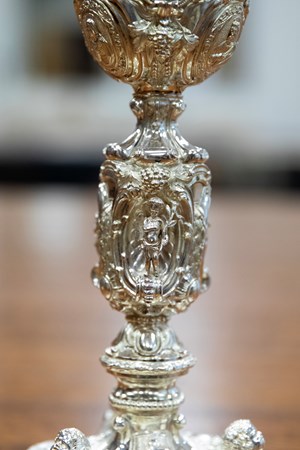 Saint Meinrad has three chalices from the Baroque period. Br. Kim chooses them to be used on special feast days, Christmas, and Easter. Fr. Jerome Bachmann, OSB, the first prior of Saint Meinrad, brought a chalice with a gold cup in a silver holder dated 1832. It is used for feasts of the “Office of the Prior” (O.P.). Another Baroque chalice of unknown date and origin commands attention because of its height and ornament. It depicts angels that represent faith, hope, and charity. Finally, a Mexican silver chalice from the 1970s is the oldest chalice in the monastery’s collection. It was a gift from a Saint Meinrad alumnus who found it in an antique store in Mexico City.
Saint Meinrad has three chalices from the Baroque period. Br. Kim chooses them to be used on special feast days, Christmas, and Easter. Fr. Jerome Bachmann, OSB, the first prior of Saint Meinrad, brought a chalice with a gold cup in a silver holder dated 1832. It is used for feasts of the “Office of the Prior” (O.P.). Another Baroque chalice of unknown date and origin commands attention because of its height and ornament. It depicts angels that represent faith, hope, and charity. Finally, a Mexican silver chalice from the 1970s is the oldest chalice in the monastery’s collection. It was a gift from a Saint Meinrad alumnus who found it in an antique store in Mexico City.
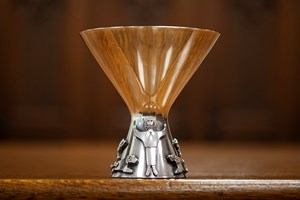 One of Br. Kim’s favorite chalices in the collection belonged to Archbishop Daniel Buechlein, OSB. It was given to him by his family and was created by Swiss goldsmith, Meinrad Burch-Korrodi. The base of the chalice depicts the biblical story of Daniel and the lions.
One of Br. Kim’s favorite chalices in the collection belonged to Archbishop Daniel Buechlein, OSB. It was given to him by his family and was created by Swiss goldsmith, Meinrad Burch-Korrodi. The base of the chalice depicts the biblical story of Daniel and the lions.
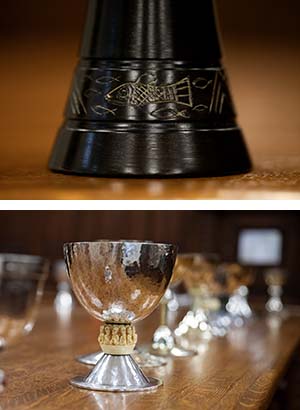 Several chalices in the collection were designed and made by monks at Saint Meinrad. Carpenter, Br. Lawrence Shidler, OSB, made a chalice for Fr. Cyprian Davis, OSB, out of ebony, a dense hardwood from Africa. Fr. Donald Walpole, OSB, created the carvings. The chalices Fr. Donald designed are identifiable by an ivory node. Fr. Eric Lies, OSB, designed his own chalice. It was executed by Arthur Neville Kirk of the Cranbrook Academy of Art. Former monk, Zachary de Bernardi made three chalices at Saint Meinrad. Most of the chalices in the collection are gold plated, but two of the ones he designed and made have gold cups.
Several chalices in the collection were designed and made by monks at Saint Meinrad. Carpenter, Br. Lawrence Shidler, OSB, made a chalice for Fr. Cyprian Davis, OSB, out of ebony, a dense hardwood from Africa. Fr. Donald Walpole, OSB, created the carvings. The chalices Fr. Donald designed are identifiable by an ivory node. Fr. Eric Lies, OSB, designed his own chalice. It was executed by Arthur Neville Kirk of the Cranbrook Academy of Art. Former monk, Zachary de Bernardi made three chalices at Saint Meinrad. Most of the chalices in the collection are gold plated, but two of the ones he designed and made have gold cups.
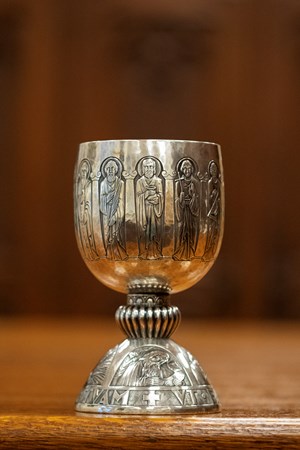 In December 1975, 18 chalices were stolen from the sacristy, including one that was gifted to Archabbot Timothy Sweeney, OSB. An exact replica of his chalice was reproduced for his 25th jubilee. In 2016, 40 years after the robbery, Br. Kim found a chalice for sale by an antique store in Kansas on eBay that resembled one that was stolen. The sterling silver chalice made in 1950 was gold plated with a design of the 12 apostles engraved on it. Br. Kim purchased the chalice, but there was no engraving on the bottom of the chalice, so he couldn’t verify that it was the stolen one.
In December 1975, 18 chalices were stolen from the sacristy, including one that was gifted to Archabbot Timothy Sweeney, OSB. An exact replica of his chalice was reproduced for his 25th jubilee. In 2016, 40 years after the robbery, Br. Kim found a chalice for sale by an antique store in Kansas on eBay that resembled one that was stolen. The sterling silver chalice made in 1950 was gold plated with a design of the 12 apostles engraved on it. Br. Kim purchased the chalice, but there was no engraving on the bottom of the chalice, so he couldn’t verify that it was the stolen one.
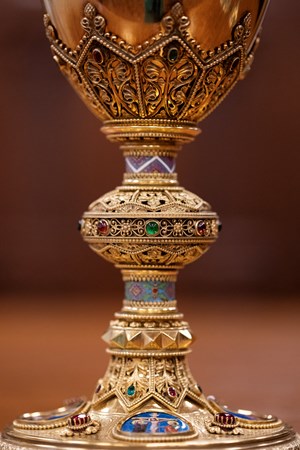 Three chalices in the collection are from Fulda, Germany, made by Wilhelm Rauscher. Fr. Anthony Vinson, OSB, pastor of St. Meinrad and Fulda, IN, parishes, led a group of parishioners on a pilgrimage to Fulda, Germany, and the tour guide’s grandfather was the artist who created the three chalices.
Three chalices in the collection are from Fulda, Germany, made by Wilhelm Rauscher. Fr. Anthony Vinson, OSB, pastor of St. Meinrad and Fulda, IN, parishes, led a group of parishioners on a pilgrimage to Fulda, Germany, and the tour guide’s grandfather was the artist who created the three chalices.